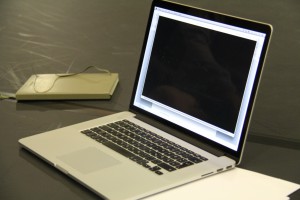I remember reading a story by Doris Lessing where she describes an alien race that can travel through time as human beings can travel through space: backwards, forwards, and sideways. Within the clearly demarcated boundaries of their lives (they, too, are born and then die), the aliens may decide when it is they spend their lives. Of course, this alien civilization experiences the same terrors as ours does: sometimes they get sick, sometimes they kill each other, sometimes they experience grief, pain, chaos, uncertainty. The aliens are aware of these times and situations but they choose not to dwell in them, they fast-forward into peace or they retreat towards their childhoods.
It is a paradox condition of our present–contemporary–era that time itself has lost its forward-moving linearity: look at the dance stages of the now and we find a multiplicity of pasts, a variety of presents, and more than a few glimpses of the future. Timeless-ness (not an aesthetic quality but a lack of being bound in time) is symptomatic of the contemporary. Imagine it as a cloud at the top of the mountain: modernity rewrote human history as relentless upward progress, but all the while it was driving its monstersup the slope. And now we, too, have arrived in a mysterious landscape, the summit is obscured by a fog, and we move through and with rifts and valleys of traditions, beings from other worlds, we dance with ancestors and time-travellers. We are in a a state of constant re-appropriation, the emergent value of which we are too small to recognize. Many are the fata morgana, swirling in the cloud.
Like the alien race, we now choose when and where to live. In examining the times and spaces available to me, I make contemporary performance. ‘Contemporary performance’ is a term I choose to inhabit, and in drawing the borders of a definition (although this is a cloud–I can see what is next to me but not far beyond that, and though I stake my claim the edges will always be contested, blurry) I recognize that there is indeed an agglomeration of questions, aesthetic practices, and economic principles that connects me more closely to some artists than to others.
Where are these borders? I choose to make a list, that anachronistic tool (too linear, too meticulous!), to sketch a topography:
1) In contemporary performance, reflexive and contextual practices make up a substantial part of the process and the performance.
2) Contemporary performance most often originates in conditions of precarity because the market demands a speed of production that makes the creation process formulaic; if a process is formulaic, it is not inventing situation-specific techniques and means. If it is not questioning its own techniques and means, then reflexive and contextual practices are not a substantial part of the creation process and performance (see 1).
3) In contemporary performance, technique is a means of putting a body into a staged situation and not the end goal of a performance itself. Technical demonstration inhabits a realm of spectacle and virtuosity that certainly exists and sometimes calls itself contemporary. However, most traditional dance technique requires a completely different relation to time than contemporary performance-making: it is accumulated through repetition, it is embodied labour. It is a miraculous thing. It is not what I do: my technique is navigation, on any given day I might do yoga, sing, take a ballet class, write, discuss, improvise, make sounds with random objects, edit a video. A contemporary performer’s greatest skill is often her ability to surf the cloud, to acquire and shed techniques as necessary. Versatile performativities, hybrid bodies.
4) In contemporary performance, presence is expanding and fading, making way for bodies remarkable for their hyper-referentiality: to pop culture, to other dance techniques and times, to gender norms, to other art disciplines, to the experience of the audience. It is a time of Wikipedia, we always refer to everything else! In this hyper-referentiality (forget Merce! The body was never just a body), contemporary performance embodies more than ever that incredibly ancient notion that the theater is a reflection of the world, that everything one can find in the microcosmos is pointing towards the macrocosmos in a way that shifts our perception, makes us see things differently. Contemporary performance reflects a society where flexibility is obligatory, where precarity is a given, where absolute truths are regarded with mistrust and where the outcome is uncertain.
…
I should write a conclusion–
but in contemporary performance, the endings are always temporary. They may not even be real. 🙂









